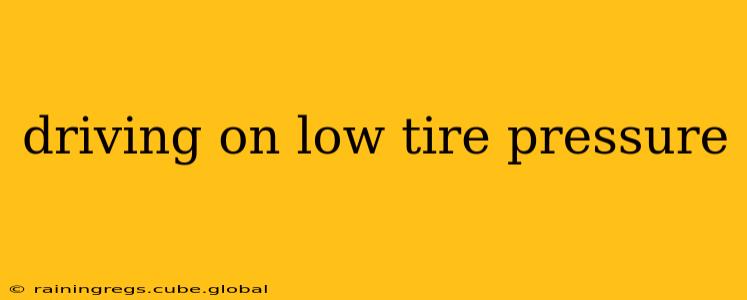Driving on low tire pressure is more dangerous than many drivers realize. It significantly impacts your vehicle's handling, fuel efficiency, and tire lifespan, potentially leading to accidents and costly repairs. This comprehensive guide will delve into the risks associated with underinflated tires, explore common causes, and provide practical solutions to ensure your safety and maintain optimal tire pressure.
What are the Risks of Driving on Low Tire Pressure?
Driving with underinflated tires presents several significant risks:
-
Reduced Fuel Efficiency: Underinflated tires increase rolling resistance, forcing your engine to work harder and consuming more fuel. This translates directly to higher gas costs and a larger carbon footprint.
-
Increased Tire Wear: Low tire pressure causes uneven wear, particularly on the outside edges of the tire. This leads to premature tire wear, requiring more frequent and costly replacements.
-
Compromised Handling and Stability: Underinflated tires reduce the contact patch between the tire and the road, diminishing traction and grip. This makes the vehicle harder to control, increasing the risk of skidding, hydroplaning, and accidents, especially in wet or icy conditions.
-
Increased Risk of Blowouts: Driving on significantly underinflated tires increases the risk of a blowout, a sudden and dangerous tire failure. This can lead to loss of control and potentially serious accidents.
-
Damage to Wheels and Suspension: The added stress on underinflated tires can also damage your wheels and suspension components, leading to expensive repairs.
Why are My Tires Low on Pressure?
Several factors can contribute to low tire pressure:
-
Natural Air Leakage: Tires naturally lose air pressure over time due to the permeability of the rubber. This is a slow process, but it's important to check your tire pressure regularly.
-
Temperature Fluctuations: Tire pressure decreases in cold weather and increases in hot weather. This is a normal phenomenon, and you should adjust your tire pressure accordingly.
-
Punctures or Leaks: A puncture from a nail, screw, or other sharp object can quickly deflate a tire. Less obvious leaks can also occur from damaged valves or sidewall punctures.
-
Improper Inflation: Incorrectly inflating your tires to a pressure lower than the recommended level is a common cause of low tire pressure. Always refer to the sticker on your driver's side doorjamb or your owner's manual for the correct tire pressure for your vehicle.
How Often Should I Check My Tire Pressure?
It's recommended to check your tire pressure at least once a month, or before any long trip. Ideally, check your tire pressure when the tires are cold (i.e., the vehicle hasn't been driven for at least three hours).
What is the Correct Tire Pressure for My Car?
The recommended tire pressure for your vehicle is usually found on a sticker located on the driver's side doorjamb, inside the glove compartment, or in your owner's manual. This sticker will specify the recommended pressure for both the front and rear tires. Always use this information as your guide, rather than relying on general guidelines.
What Should I Do If I Notice Low Tire Pressure?
If you notice low tire pressure, do not drive on it for extended periods. Pull over to a safe location as soon as possible. If you can safely do so, inflate the tire to the correct pressure using a portable air compressor or at a gas station. If the tire is severely underinflated or damaged, have it inspected and repaired by a qualified tire professional.
Can I Drive on a Slightly Underinflated Tire?
While driving on a slightly underinflated tire might seem harmless in the short term, it's not advisable. Even a small difference in pressure can significantly impact fuel efficiency, tire wear, and handling. It's always best to maintain the correct tire pressure for optimal performance and safety.
How Can I Prevent Low Tire Pressure?
Regularly checking your tire pressure, maintaining the correct inflation levels, and visually inspecting your tires for any damage are crucial steps in preventing low tire pressure. Regular tire rotations can also promote even tire wear and extend their lifespan.
By following these guidelines, you can minimize the risks associated with driving on low tire pressure and ensure a safer, more efficient, and more cost-effective driving experience. Remember, your safety and the safety of others depend on properly maintained tires.
